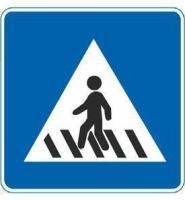1、There is a risk of overtaking when driving a motor vehicle approaches the top of the slope on a mountainous road, because _____.
A、When approaching the top of the slope, the line of sight is blocked and it is impossible to observe the traffic situation.
B、When approaching the top of the slope, the line of sight is blocked. It is impossible to observe whether there are obstacles behind the top of the slope.
C、The speed is slower when approaching the top of the slope.
D、When approaching the top of the slope, the line of sight is blocked and the road direction behind the top of the slope can not be observed.
Answer:ABD
2、When a tire bursts suddenly on the road, the driver should refrain from violently depressing the brake pedal in panic. Instead, he/she should try his/her best to change to a low gear and use engine braking to reduce the speed of the vehicle.
A、Right
B、Wrong
Answer:A
3、When the driver discovers a tire is leaking and steers the vehicle off the main carriageway, he should refrain from applying emergency so as to avoid a vehicle turnover or a rear-end collision arising from the late braking of the following vehicle.
A、Right
B、Wrong
Answer:A
4、While driving a motorcycle, nothing is permitted to hang on the handlebars.
A、Right
B、Wrong
Answer:A
5、When seeing this sign, the driver should reduce speed and observe the road conditions.

A、Right
B、Wrong
Answer:A
6、It is not a bad habit for a driver to frequently change lanes.
A、Right
B、Wrong
Answer:B
7、What is the main impact of foggy weather on safe driving?
A、Easy to slide sideways
B、Low visibility
C、Increase the resistance
D、Widen the field of vision
Answer:B
8、What are the main reason for not applying emergency braking when driving on rainy days?
A、Increase fuel consumption
B、Reduce fuel consumption
C、The tires can easily spin
D、Easy to cause rear-end collision
Answer:CD
9、Which of the following is a bad habit when changing lanes?
A、Turning on the indicator in advance
B、Observing closely before changing a lane
C、Change lanes at will
D、Not obstructing the passing of other normally moving vehicles
Answer:C
10、When driving on a long downhill road, which is the best way to control driving speed?
A、Coast in neutral gear
B、Depress the clutch and coast
C、Use the engine to brake
D、Depress the brake pedal continuously
Answer:C
11、What is the meaning of this sign?

A、Driving at reduced speed in the section of 40 meters
B、Minimum speed is 40km/hr
C、Maximum speed is 40km/hr
D、40km/hr speed limit ban is lifted
Answer:D
12、When a vehicle encounters a strong side wind in a mountain valley, the driver should drastically turn the steering handlebar to adjust the direction of the vehicle if he feels the vehicle deviates from the normal direction.
A、Right
B、Wrong
Answer:B
13、When encountering an obstacle on one side of the road, what should vehicles do as they approach each other?
A、The vehicle not encountering an obstacle should Yield to the other vehicle
B、The slower vehicle should yield to the faster
C、The vehicle encountering an obstacle should yield to the other vehicle
D、The faster vehicle should yield to the slower
Answer:C
14、How should a motor vehicle follow the other vehicle In front when driving on a road covered with ice and snow?
A、Keep a long safe distance
B、Turn on hazard lamp
C、Change between high-and-low beam alternatively
D、Sound the horn in due time to give a notice to the vehicle in front
Answer:A
15、when passing an intersection without traffic lights, the driver finds people are crossing the street, the wrong measure for the driver to take is to __________.
A、Reduce speed or stop and yield
B、Honk to urge the pedestrians
C、Bypass
D、Weave through the pedestrians
Answer:BCD
16、What influence does smoking have upon driving?
A、Harmful for safe driving
B、Increase concentration
C、Help relaxation
D、No effect on driving
Answer:A
17、Which measures is correct when a motor vehicle intends to overtake
A、Use the high and low beam lights alternately to indicate the intention
B、Honk to indicate the vehicle
C、Speed up and overtake on the right side
D、Turn on the left-turn signal in advance
Answer:ABD
18、Serious wave will appear when the front tire blows out; the driver should release the accelerator, firmly hold the steering wheel with both hands, quickly gradually break down, and stop to yield.
A、Right
B、Wrong
Answer:A
19、Before riding a motorcycle, the driver should wear a safety helmet and adjust the angle of the rearview mirror till he can clearly watch the left side and the right side of the back.
A、Right
B、Wrong
Answer:A
20、What is the meaning of this sign?

A、Intersection
B、Ring intersection
C、T-shaped intersection
D、Y-shaped intersection
Answer:A
21、When a fast-moving vehicle encounters an emergency the driver should turn to evade first and then brake to slow down so as to mitigate the damage.
A、Right
B、Wrong
Answer:B
22、What is the meaning of this sign?

A、Watch for pedestrians
B、Crosswalk
C、Village or town
D、Primary school
Answer:C
23、What is the meaning of this sign?

A、Passing by the right side
B、Passing by the left side
C、Running to right side
D、Running the roundabout
Answer:D
24、When encountering non-motorized vehicles cutting in on the road, the driver should ________.
A、Honk to warn
B、Speed up and bypass from the front
C、Voluntarily reduce speed and yield
D、Suddenly speed up when approaching
Answer:C
25、When encountering dangerous and complicated circumstance, the driver should keep medium or low speed and keep the balance of the motorcycle to pass it cautiously.
A、Right
B、Wrong
Answer:A